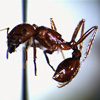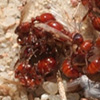

 |
 |
 |
Western harvester ants (Pogonomyrmex occidentalis) are widely distributed in the Western United States. They build mounds up to 4 feet across and 2–10 inches high, removing all plants around the mound, which they often cover with small pebbles, charcoal, or dead leaves to keep the nests warm. They feed upon seeds and insects.
The small objects harvester ants collect are not always pebbles and seeds--they sometimes collect tiny fossils and archaeological artifacts. Paleontologists and archaeologists often use harvester ant mounds to find microfossils, beads, and other small artifacts. To avoid disturbing the ants, it is best to collect only the surface layer of the mound while the ants are hibernating for the winter. Harvester ants rebuild their mounds when they emerge in spring.
Explore our BioLounge exhibit and this website to learn more about these tiny collectors and how they help us learn about the past!
Learn more about the complex systems of ant colonies from Deborah Gordon and about the social behavior of ants from E.O. Wilson, or find out about the plants harvester ants collect.